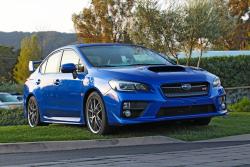 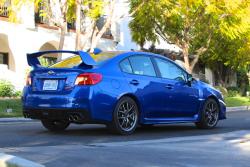 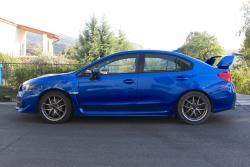 2015 Subaru WRX STI. Click image to enlarge |
Originally published March 21, 2014
Review and photos by Jonathan Yarkony
Ojai, California – Masuo Takatsu is an avid surfer. He also is the Project General Manager for the 2015 Subaru WRX STI.
The key goal of this generation WRX STI’s redesign was to improve, first and foremost, the handling. The lessons of surfing were not lost on Takatsu-san, who uses the principles of surfing to explain the one of the three cornerstones of the WRX STI’s handling improvements: rear grip.
On a surfboard, the rear foot locks down the board, using the body’s weight to ensure stability on the water and an axis on which to pivot, allowing the front foot to steer the board. So too, must the rear end of a car maintain its grip and allow the front wheels to guide the car along its path.
In order to demonstrate this principle, Subaru invited us to Buttonwillow race track outside of Bakersfield, California, a long, winding track in the middle of the California desert where we could have our way with the new 2015 WRX STI and WRX, as well as their predecessors, the 2014 models. What a difference a year makes.
In order to achieve this rear traction, the entire body and chassis were redesigned, starting with a significant increase in the use of high-strength steel (up 30 percent), and even adding key structural components (A-pillar, roof cross-member) made from lighter, stiffer hot-stamped steel (part of the process used to make Samurai swords). Reducing the weight and increasing the strength allowed Subaru to add structural reinforcements to the A pillar, underfloor, and rear apron and floor. The results: total bending rigidity is up 30 percent, while torsional rigidity is up 40 percent.
This stiffening continues to the suspension, in which the subframe, cross-members, control arms, bushings and springs are stiffer, and stabilizer bars increased in diameter 1 mm in back (19 to 20 mm) and 3 mm in front (21 to 24 mm). The results here are 14 and 38 percent improvements in lateral stiffness front and rear, and overall 24 percent improvement in roll stiffness. The suspension and body stiffness are inextricably linked to the second key in Takatsu’s redesign handling goals: flat cornering attitude. The flat ride allows the car to maintain a stable stance and keeps the car’s rear end planted while the front contact patches direct the car.
This incredible investment in body rigidity is also part of the reason we see only the sedan body style – imagine the expense of developing all these improvements twice over… as much as we are hatchback and wagon devotees, we must all recognize the realities that a smaller manufacturer like Subaru must face. Sedans are what sell, even if Subaru faithful contain a far higher proportion of five-door aficionados than your average mainstream brand. However, I spoke with one WRX wagon owner that would be perfectly willing willing-with-much-grumbling to trade the practicality of his beloved hatch for the kind of improvements this generation brings to bear in the handling and steering departments. Yeah, it’s that good.
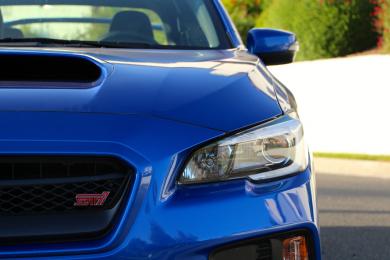 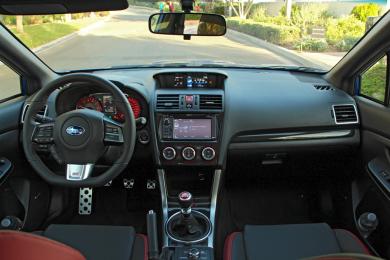 2015 Subaru WRX STI. Click image to enlarge |
Oh, did I mention steering? Subaru has gone against the grain of pretty much every other performance car launched over the past few years and retained a hydraulic power steering setup for the STI (the WRX goes to electric assistance). However, the steering on the previous generation WRX STI was no great shakes, and in fact, it was one of the sore spots for that car. Some might even say it was bad….
Well, STI fans rejoice! With 400 percent (no that’s not a typo, four hundred!) stiffer mount bushings, 125 percent more rigid torsion bar, and a quicker ratio (from 15:1 to 13:1), the steering is a revelation. Without being needlessly heavy, the steering is direct and purposeful, with a clarity that will be appreciated by those that suffered the WRX and STI’s formerly woolen and loose steering response in corners. It’s a perfect complement to the flat ride and rear grip, and the third and final of Masuo Takatsu’s three pillars of handling improvements envisioned for this fourth-generation WRX STI.
All these engineering specs are just dandy, but they come alive in a way that would shock you. Now, Subaru knows just how significant the improvements are, which is why they were so insistent we drive the 2015 WRX STI back to back with the 2014 on the track. That experience drove home all the wild claims Subaru has been making recently (such as: the steering on the WRX is better than the BRZ). We had no idea how right they were.
After spending the morning driving to the track in the WRX (to be covered fully in its own review), the STIs were lined up and ready to go as soon as we finished our trackside lunch. The seats were immediately accommodating, with taller backrests, separate, adjustable head restraints (safer and more comfortable) and greater adjustability, but even more aggressive bolstering without being too narrow to put the squeeze on a 200-pounder like myself. The new steering wheel is thicker, of smaller diameter with a flat bottom, but the same familiar steering wheel controls.
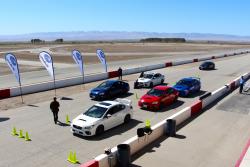 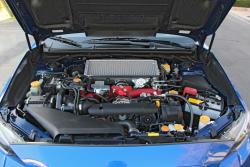 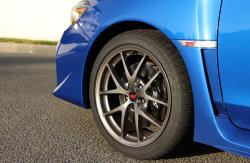 2015 Subaru WRX STI. Click image to enlarge |
Firing up with the push-button start brings the familiar turbocharged, intercooled 2.5L flat-four to life, the unique rumble from its uneven headers now fortified by a special “sound creator” that directs some portion of the air intake through a damper and into the cabin to accentuate this signature Boxer’s unique pulsating voice at high revs. So yeah, it sounds even more like a growly STI Boxer.
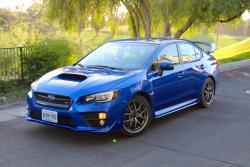 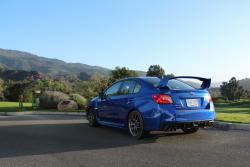 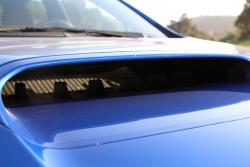 2015 Subaru WRX STI. Click image to enlarge |
Its peak 305 hp remains unchanged, arriving at 5,600 rpm, and the 290 lb-ft of torque arrive slightly earlier at 4,000 rpm and stays mostly on tap until falling off at 6,000 rpm. Subaru claims the peak power arrives earlier and stays longer, but more extensive track testing would be in order to confirm these subtle changes (hint, hint), but there is no doubt the throttle response is quicker thanks to changes in the ECU mapping.
There is no question 305 hp is just plenty for the STI’s 1,527–1,564 kg, and the 5 kg/hp power-to-weight ratio puts it ahead of it nemesis, the Mitsubishi Evo (about 5.5). With that kind of power and throttle response, the STI shoots out of corners with menace and sends dirt clouds choking up the hazy sky if you happen to launch from a gravel shoulder. Or at least so I’m told. Power is as good as it’s ever been and entirely satisfying in the mid-to-high rpm range.
Doesn’t hurt that the STI has one of the most effective all-wheel-drive systems on the market, carrying over the multi-mode DCCD (driver-controlled centre differential) system that can automatically vary torque between front and rear axles with a bias to the front or rear, or be adjusted to specific splits between front and rear, from 50:50 to 41:59. STI also retains mechanical limited slip differentials on both axles, of the helical type in front and TorSen at the rear. It’s a bit old-school, but it is unquestionably brilliant, and the power flows to the wheels in a seamless waves as you rotate, slip and slide in, through and out of corners.
One advance Subaru has made with their signature Symmetrical AWD system is torque vectoring, including both inside front wheel braking via the vehicle’s VDC (Vehicle Dynamic Control, Subaru’s term for traction and stability control) and active torque distribution to the outside front wheel. For track use and big snowy parking lots, VDC can be disabled while retaining the active torque vectoring.
The only transmission for the STI remains the six-speed manual transmission, breathed on just enough for Subaru reps to have something to talk about. It retains its ratios and mechanical linkage, but apparently has enhanced detents for better feel and smoother shifting. I think I’m coming around on the STI shifter, because I did enjoy the shifter and clutch feel, but I was not happy with the brake and gas pedal setup – it’s set up for a different style of heel-toe downshifting than I have learned, so that made me grumpy that I had great difficulty blipping the throttle on downshift corners.
But I couldn’t stay grumpy for long, not with this amazing sport compact a willing weapon at my hands. My last foray in a 2014 STI convinced me of its tenacious grip and left an indelible impression on a few lucky passengers around a lonely clear onramp, but our back-to-back drives showed us just how much was left to exploit from this engine.
About time we talked about the actual handling, anyway, isn’t it?
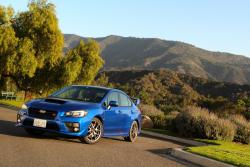 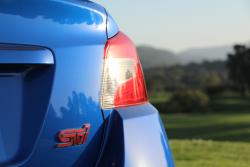 2015 Subaru WRX STI. Click image to enlarge |
From the first corner it was apparent that the new platform was something special, and ensuing laps only cemented this revelation. In places where the 2014 STI was bobbing, weaving and swaying under the extreme loads of full-force braking and lateral acceleration, the 2015 stayed planted and composed, only a hint of its predecessor’s body lean, pitch and dive. And while it tracks through corners, the steering is firm and consistent, its steering response near as quick as the best sports cars on the market. Where the 2014 had me clenching my way through some of Buttonwillow’s tricky corners, the ’15 was easy to read and generated immense confidence and allowed me to quickly improve and negotiate the racing line without doubt and fewer mistakes. It lives up to the adage of a car able to make a better driver in the tradition of the Miata, Boxster, M3 and 911.
But don’t just take my word for it, Tommi Mäkinen, four-time WRC champ (with Mitsubishi, ironically, but later moved to Subaru) was on hand and helped in its development. While taking us for hot laps around Buttonwillow (hot enough to catch some air over a blind-crest turn while steering with one hand and talking with the other), Mäkinen also conveyed his appreciation for how easy the STI was to control thanks to its newfound handling and precise steering. Mäkinen also stressed the importance of that planted rear end for better turn-in and balance in corners.
The return trip from Buttonwillow in the STI showed us some of its road manners, where it is sufficiently quiet in the cabin to have a relaxed conversation or listen to the stereo at a low volume. The stereo in our Sport-Tech STI was a new 440W nine-speaker Harman/Kardon system that delivered a focus on bass that Subaru has noted is the preference in its customer base.
Oh, and speaking of its customer base, no gold wheels for Canada? Shame on you, Subaru!
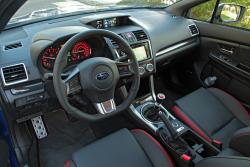 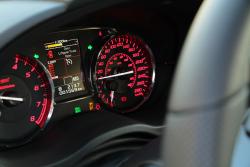 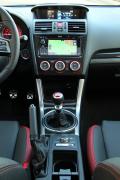 2015 Subaru WRX STI. Click image to enlarge |
Anyhow, the interface itself to control the navigation and audio functions remains a mediocre but functional touchscreen. The interior is much improved, but is still relegated to a lesser priority, with high-quality soft-touch materials at key contact points throughout the cabin, but cheesy headliner and simple, functional if plain interior design. We’ll take it, so long as Subaru keeps investing money in the right places, like the chassis, steering and a racing programs that has seen two class wins at the 24 Hours of Nürburgring after leaving WRC to focus on tarmac performance.
Is it perfect? Of course not, those epic handling chops come with a correspondingly sharp ride – this thing bucks and crashes with only the slightest layer of damping to take a slight edge off, so you must be truly committed to accept this ride quality in a daily driver unless you live in a magic land without potholes and rough roads.
Masuo Takatsu’s mission was to complement the STI’s already prodigious power and traction with an equal measure of control in having it behave as the driver intends. Mission accomplished. The Subaru WRX STI has gone from a powerful hooligan to a powerful assassin, able to pick off corners with deadly precision and turn any drive into a joyful experience thanks to direct, communicative steering, superlative handling and that signature turbo-boxer power and AWD mastery.
Pricing: 2015 Subaru WRX STI
Base Price: $37,995
Standard Equipment: Six-speed manual transmission, 18-inch Dark Gunmetal aluminum wheels, front and rear Brembo brakes, Sound creator (engine sound enhancement), wide-body design, front bumper under-spoiler, rear bumper under-spoiler and rocker spoiler, three-spoke, flat-bottom leather-wrapped steering wheel with red stitching and audio, Bluetooth and cruise control switches, performance-design front seats with separate height- and tilt- adjustable head restraints, high-grip Alcantara/Leather upholstery with red stitching, Electroluminescent instrument panel gauges with LCD colour display, 4.3-inch multi-function colour display with centre-console-mounted control (boost display, vehicle dynamics monitor, clock, outside temperature, maintenance reminder, customizable settings), Dual zone automatic climate control
Sport: $40,495
Equipment: Big honking trunk spoiler, power tilt/slide glass sunroof, LED low-beam automatic headlights, multi-reflector halogen high beams, multi-reflector halogen fog lights, eight-way power driver’s seat, welcome lighting
Sport-Tech: $44,995
Equipment: 18-inch BBS forged aluminum wheels, proximity key with push-button start, Harman/Kardon 440-Watt amplifier, Harman/Kardon premium speaker system (nine speakers, including subwoofer), leather seating surfaces, voice-activated, in-dash GPS navigation system with 6.1-inch high-resolution touchscreen, AM/FM/CD/MP3/WMA/DivX, WMV, MP4, SMS text messaging capability, AHA radio, XM NAVTraffic (subscription required), 3.5 mm auxiliary jack, USB, Bluetooth mobile phone connectivity with voice activation and Bluetooth streaming audio, SiriusXM Satellite Radio installed (free three-month trial subscription included)











































